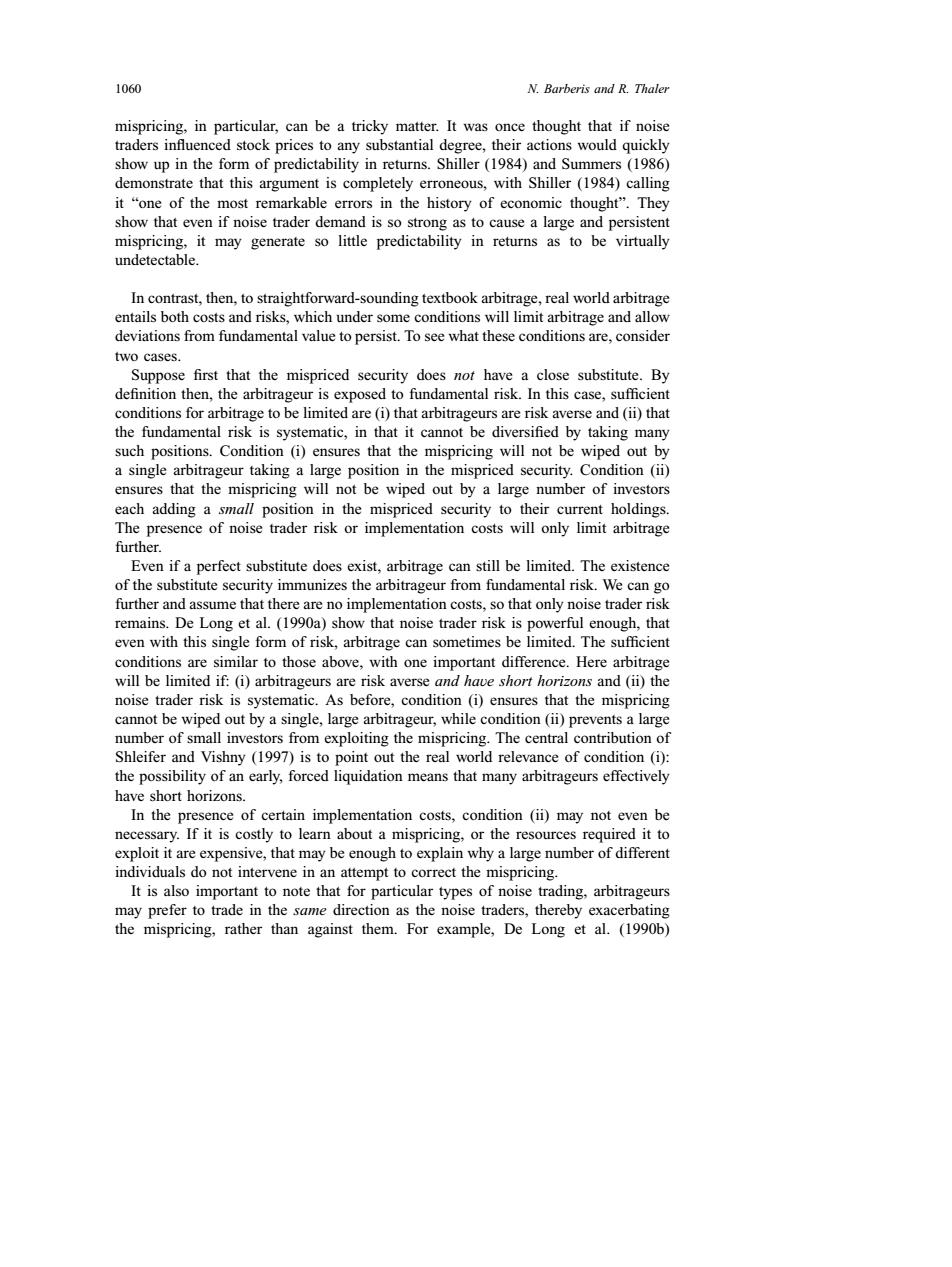正在加载图片...

1060 N.Barberis and R.Thaler mispricing,in particular,can be a tricky matter.It was once thought that if noise traders influenced stock prices to any substantial degree,their actions would quickly show up in the form of predictability in returns.Shiller(1984)and Summers (1986) demonstrate that this argument is completely erroneous,with Shiller(1984)calling it "one of the most remarkable errors in the history of economic thought".They show that even if noise trader demand is so strong as to cause a large and persistent mispricing,it may generate so little predictability in returns as to be virtually undetectable In contrast,then,to straightforward-sounding textbook arbitrage,real world arbitrage entails both costs and risks,which under some conditions will limit arbitrage and allow deviations from fundamental value to persist.To see what these conditions are,consider two cases. Suppose first that the mispriced security does not have a close substitute.By definition then,the arbitrageur is exposed to fundamental risk.In this case,sufficient conditions for arbitrage to be limited are(i)that arbitrageurs are risk averse and(ii)that the fundamental risk is systematic,in that it cannot be diversified by taking many such positions.Condition(i)ensures that the mispricing will not be wiped out by a single arbitrageur taking a large position in the mispriced security.Condition(ii) ensures that the mispricing will not be wiped out by a large number of investors each adding a small position in the mispriced security to their current holdings. The presence of noise trader risk or implementation costs will only limit arbitrage further. Even if a perfect substitute does exist,arbitrage can still be limited.The existence of the substitute security immunizes the arbitrageur from fundamental risk.We can go further and assume that there are no implementation costs,so that only noise trader risk remains.De Long et al.(1990a)show that noise trader risk is powerful enough,that even with this single form of risk,arbitrage can sometimes be limited.The sufficient conditions are similar to those above,with one important difference.Here arbitrage will be limited if:(i)arbitrageurs are risk averse and have short horizons and(ii)the noise trader risk is systematic.As before,condition (i)ensures that the mispricing cannot be wiped out by a single,large arbitrageur,while condition(ii)prevents a large number of small investors from exploiting the mispricing.The central contribution of Shleifer and Vishny (1997)is to point out the real world relevance of condition (i): the possibility of an early,forced liquidation means that many arbitrageurs effectively have short horizons. In the presence of certain implementation costs,condition (ii)may not even be necessary.If it is costly to learn about a mispricing,or the resources required it to exploit it are expensive,that may be enough to explain why a large number of different individuals do not intervene in an attempt to correct the mispricing It is also important to note that for particular types of noise trading,arbitrageurs may prefer to trade in the same direction as the noise traders,thereby exacerbating the mispricing,rather than against them.For example,De Long et al.(1990b)1060 N. Barberis and R. Thaler mispricing, in particular, can be a tricky matter. It was once thought that if noise traders influenced stock prices to any substantial degree, their actions would quickly show up in the form of predictability in returns. Shiller (1984) and Summers (1986) demonstrate that this argument is completely erroneous, with Shiller (1984) calling it “one of the most remarkable errors in the history of economic thought”. They show that even if noise trader demand is so strong as to cause a large and persistent mispricing, it may generate so little predictability in returns as to be virtually undetectable. In contrast, then, to straightforward-sounding textbook arbitrage, real world arbitrage entails both costs and risks, which under some conditions will limit arbitrage and allow deviations from fundamental value to persist. To see what these conditions are, consider two cases. Suppose first that the mispriced security does not have a close substitute. By definition then, the arbitrageur is exposed to fundamental risk. In this case, sufficient conditions for arbitrage to be limited are (i) that arbitrageurs are risk averse and (ii) that the fundamental risk is systematic, in that it cannot be diversified by taking many such positions. Condition (i) ensures that the mispricing will not be wiped out by a single arbitrageur taking a large position in the mispriced security. Condition (ii) ensures that the mispricing will not be wiped out by a large number of investors each adding a small position in the mispriced security to their current holdings. The presence of noise trader risk or implementation costs will only limit arbitrage further. Even if a perfect substitute does exist, arbitrage can still be limited. The existence of the substitute security immunizes the arbitrageur from fundamental risk. We can go further and assume that there are no implementation costs, so that only noise trader risk remains. De Long et al. (1990a) show that noise trader risk is powerful enough, that even with this single form of risk, arbitrage can sometimes be limited. The sufficient conditions are similar to those above, with one important difference. Here arbitrage will be limited if: (i) arbitrageurs are risk averse and have short horizons and (ii) the noise trader risk is systematic. As before, condition (i) ensures that the mispricing cannot be wiped out by a single, large arbitrageur, while condition (ii) prevents a large number of small investors from exploiting the mispricing. The central contribution of Shleifer and Vishny (1997) is to point out the real world relevance of condition (i): the possibility of an early, forced liquidation means that many arbitrageurs effectively have short horizons. In the presence of certain implementation costs, condition (ii) may not even be necessary. If it is costly to learn about a mispricing, or the resources required it to exploit it are expensive, that may be enough to explain why a large number of different individuals do not intervene in an attempt to correct the mispricing. It is also important to note that for particular types of noise trading, arbitrageurs may prefer to trade in the same direction as the noise traders, thereby exacerbating the mispricing, rather than against them. For example, De Long et al. (1990b)